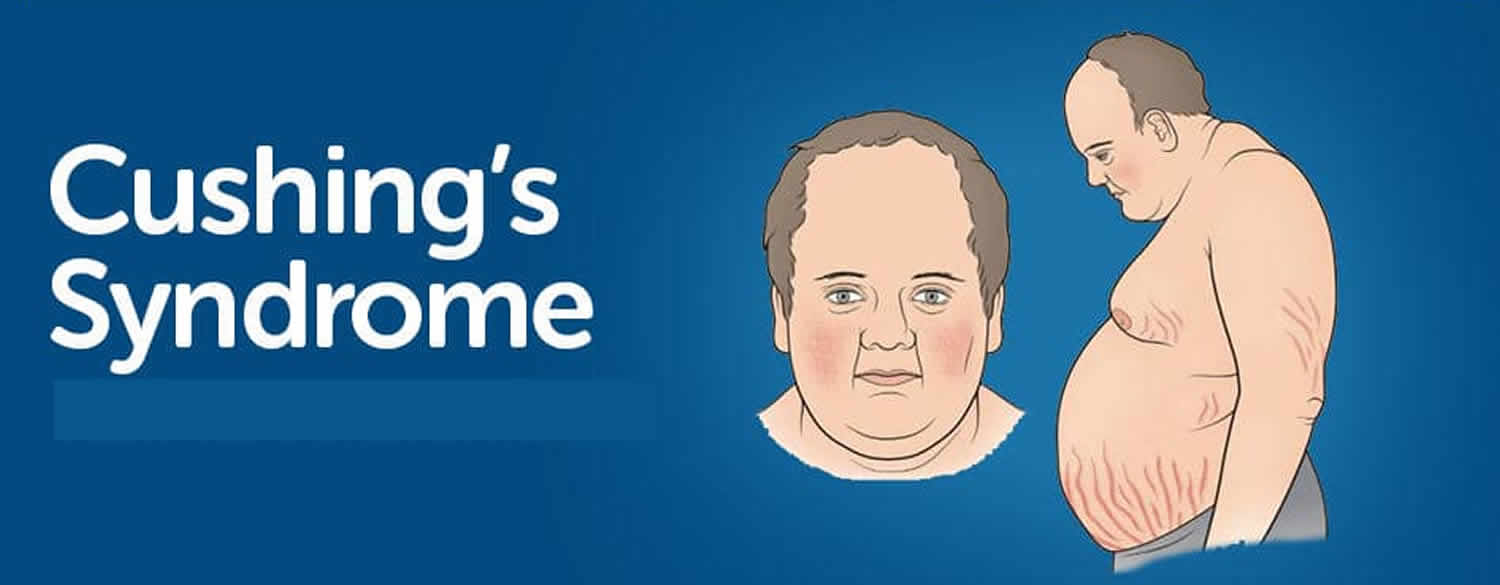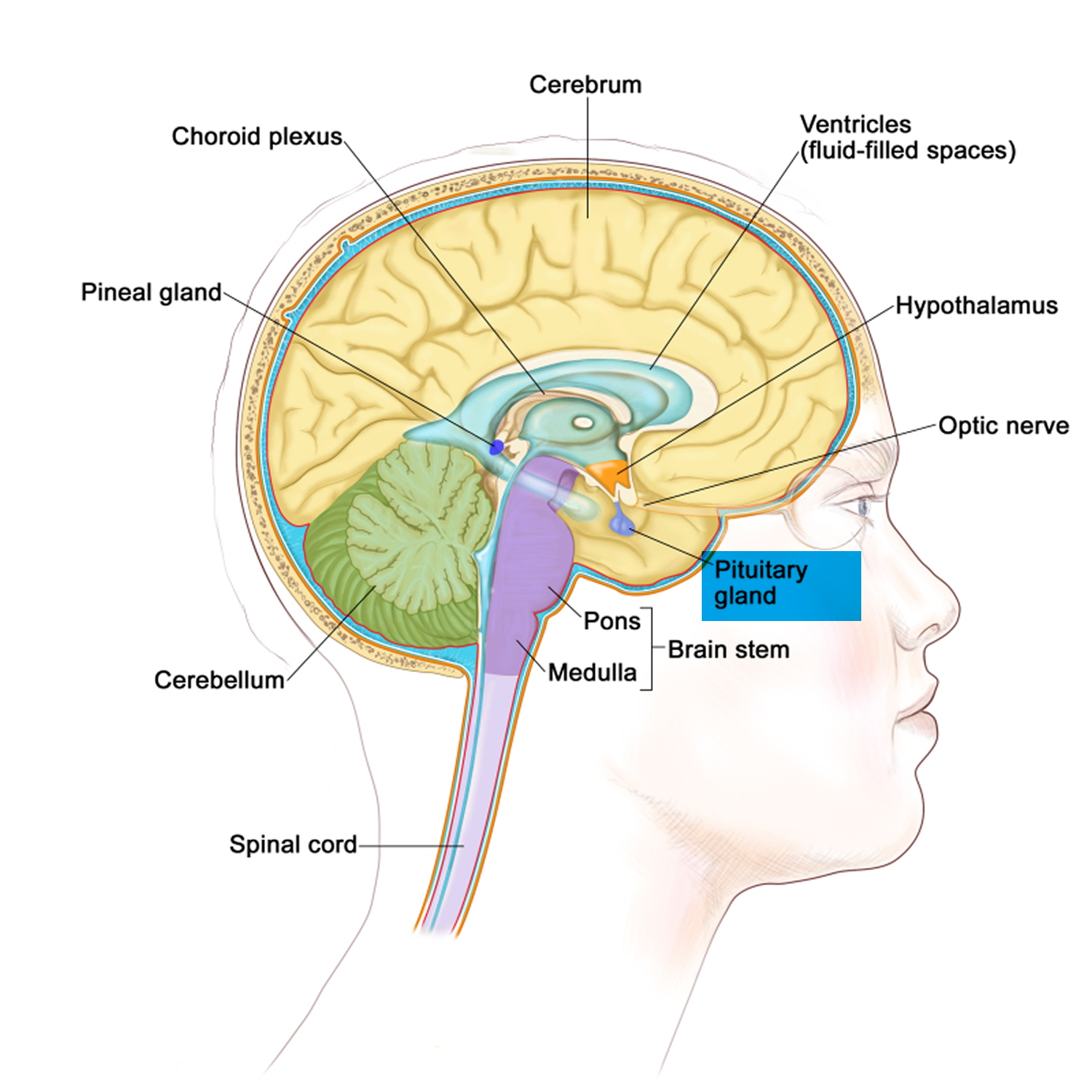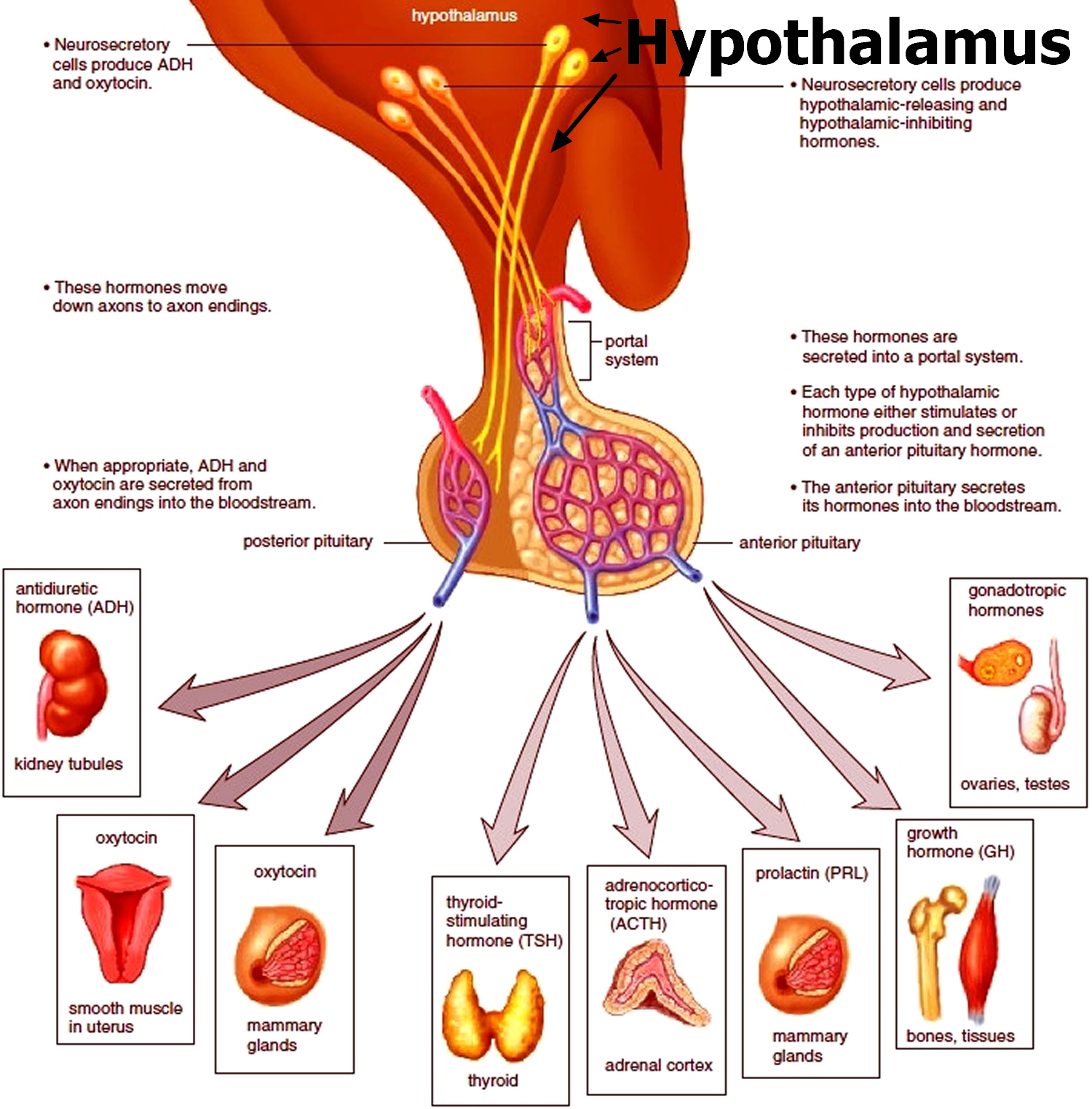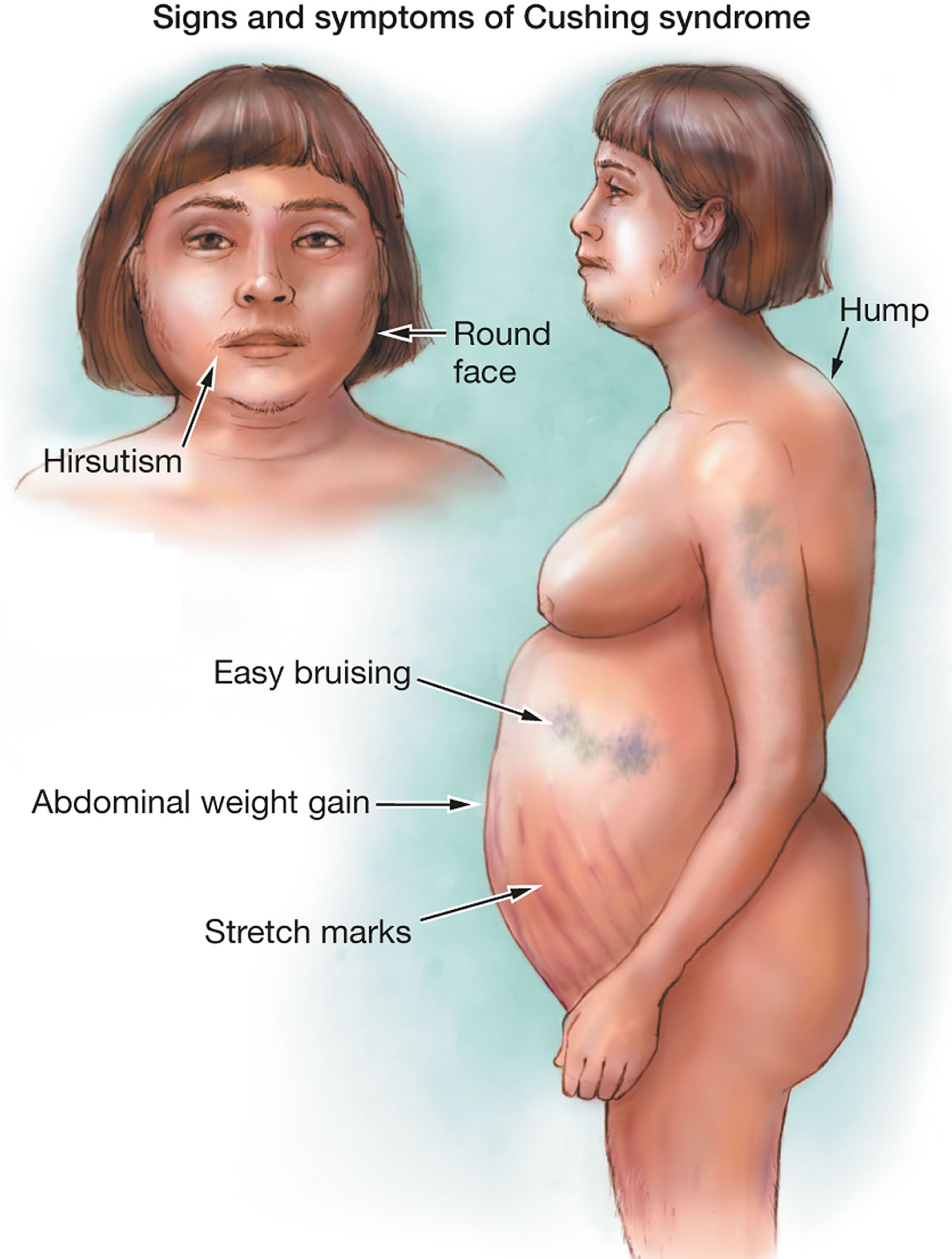Contents
What is Cushing syndrome
Cushing syndrome (also sometimes called Cushing’s syndrome) is a condition where your body is exposed to too much of the hormone cortisol. This can be because your body is making too much cortisol, or because you have taken a lot of oral corticosteroid medicines. If you have Cushing’s syndrome, it is treatable. However Cushing’s syndrome can be serious if it’s not treated. The condition is named after Harvey Cushing, an eminent American neurosurgeon, who described the first patients with this condition in 1912.
Cortisol is a hormone that is made by the adrenal glands. You have two adrenal glands, one sitting on the top of each kidney.
Cortisol is a hormone that it is vital for life.
Cortisol hormone has several important functions including:
- Cortisol helps to regulate blood pressure
- Cortisol helps to regulate the immune system
- Cortisol helps to balance the effect of insulin to keep blood sugar normal by converting fat, carbohydrates, and proteins into energy
- Cortisol helps the body to respond to stress
Cortisol is involved in many different parts of your body. It is produced all day, and especially during times of stress.
- Some people with Cushing’s syndrome have a benign tumor in part of the brain. This tumor tells the adrenal glands to release cortisol. This condition is known as Cushing’s disease.
- Other people develop Cushing’s syndrome from taking steroid medication for a long time. If you have Cushing’s syndrome as a result of taking steroid medication, do not stop taking it suddenly, as you could become very unwell. Talk to your doctor.
- Cushing’s syndrome can also be caused by a tumor of the adrenal gland, overgrowth of the adrenal glands, or occasionally a tumor somewhere else in the body.
Cushing’s syndrome is uncommon. It mostly affects people who have been taking steroid medicine, especially steroid tablets, for a long time. Steroids contain a man-made version of cortisol. For example taking a steroid such as prednisolone for asthma, arthritis or colitis.
Very rarely, it can be caused by the body producing too much cortisol. This is usually due to:
- a growth (tumor) in the pituitary gland in the brain
- a tumor in one of the adrenal glands above the kidneys
The tumors are usually non-cancerous (benign). Far more women than men suffer from Cushing’s syndrome but it isn’t known why; it is most commonly diagnosed between the ages of 30 to 40. Although it is rare in children, some as young as 6 have been diagnosed. There are no environmental triggers known and it’s not hereditary.
Spontaneous Cushing’s syndrome, originating from within the body is rare, but occurs when the adrenal glands are making too much of a hormone called cortisol (the body’s natural glucocorticoid steroid hormone). The quoted incidence of Cushing’s syndrome is 1 in 200,000 but it is now being found more frequently when it is specifically investigated. The difficulty is that the symptoms of Cushing’s syndrome can be very wide ranging and thus the diagnosis may not necessarily be considered; it can be difficult to establish, at the earlier stages and this can cause a delay in diagnosis.
The commonest cause of spontaneous Cushing’s syndrome (around 70%) is a small benign tumor (growth) of the pituitary gland (a small gland at the base of the brain, behind the bridge of the nose). This produces the hormone called ACTH, (adrenocorticotrophic hormone), that goes through the blood stream to the adrenal glands and causes them to release too much cortisol. In this case there is a good chance that an operation on your pituitary gland will solve the problem. Alternatively, there could be a small growth in another part of your body which is having the same effect (this is called ectopic ACTH). If so, removing this growth will usually solve the problem. Lastly, there may be a small growth in one of the adrenal glands themselves, in which case an operation will be needed to remove that gland. In some circumstances it may be necessary to remove both adrenal glands to solve the problem.
Strictly speaking, if the source of the problem is the pituitary gland, then the correct name is Cushing’s Disease.
Figure 1. The pituitary gland location
Figure 2. Pituitary gland
Figure 3. The hypothalamus and pituitary gland (anterior and posterior) endocrine pathways and target organs
See a doctor if you have symptoms of Cushing’s syndrome, especially if you’re taking steroids.
Don’t stop taking your medicine without getting medical advice.
Lots of things can cause similar symptoms to Cushing’s syndrome, so it’s a good idea to get checked to find out what the problem is.
Cushing syndrome vs Cushing disease
Cushing disease is caused by a tumor or excess growth (hyperplasia) of the pituitary gland that produces too much adrenocorticotropic hormone (ACTH). The excess adrenocorticotropic hormone (ACTH) stimulates the excessive production and release of cortisol by your adrenal glands. Too much ACTH causes the adrenal glands to make too much cortisol.
A type of pituitary tumor called an adenoma is the most common cause of Cushing disease. An adenoma is a benign tumor (not a cancer).
Cushing disease can also occur with excess growth of the pituitary gland. The excessive growth, known as hyperplasia, also causes the release of too much ACTH, which then leads to over-production of cortisol.
Cushing syndrome and Cushing disease are both conditions that occur when the body produces too much cortisol. Cortisol is normally released during stressful situations. It controls the body’s use of carbohydrates, fats, and proteins. It also reduces the immune system’s response to swelling (inflammation).
Both Cushing syndrome and Cushing disease cause the same symptoms, including red lines on the abdomen, abdominal weight gain, and roundness to the face.
What causes Cushing disease?
Cushing disease is a relatively rare condition, only affecting 10 to 15 people per million every year. It is more common in women and occurs most often in people between the ages of 20 and 50. Adenoma is the most common cause of Cushing disease. Adenoma is a pituitary tumor that is almost always benign. The tumors can be hard to diagnose, because they are quite small, so many people who have Cushing disease have a delayed diagnosis. Having an endocrinologist help with the diagnostic process can improve the chances of a prompt, successful diagnosis for patients who have symptoms of Cushing syndrome and Cushing disease.
Signs and symptoms of Cushing disease (except for the cause, both Cushing syndrome and Cushing disease cause the same signs and symptoms)
Symptoms of Cushing disease include:
- Upper body obesity (above the waist) and thin arms and legs
- Round, red, full face (moon face)
- Slow growth rate in children
Skin changes that are often seen include:
- Acne or skin infections
- Purple stretch marks (1/2 inch or 1 centimeter or more wide), called striae, on the skin of the abdomen, thighs, upper arms, and breasts
- Thin skin with easy bruising, most commonly on the arms and hands
Muscle and bone changes include:
- Backache, which occurs with routine activities
- Bone pain or tenderness
- Collection of fat between the shoulders (buffalo hump)
- Weakening of the bones, which leads to rib and spine fractures
- Weak muscles
Women may have:
- Excess hair growth on the face, neck, chest, abdomen, and thighs
- Menstrual cycle that becomes irregular or stops
Men may have:
- Decreased or no desire for sex (low libido)
- Erection problems
Other symptoms or problems may include:
- Mental changes, such as depression, anxiety, or changes in behavior
- Fatigue
- Frequent infections
- Headache
- Increased thirst and urination
- High blood pressure
- Diabetes
Cushing disease possible complications
Health problems that may result from Cushing disease include:
- Compression fractures in the spine
- Diabetes
- High blood pressure
- Infections
- Kidney stones
- Mood or other psychiatric problems
How is Cushing disease treated?
Untreated, Cushing disease can cause severe illness, even death. Removal of the tumor may lead to full recovery, but the tumor can grow back.
The first line therapy is surgical removal of the tumor. Cure rates with an experienced pituitary surgeon are about 90% in people with small tumors. A patient will typically have trans-sphenoidal microsurgery through the nasal sinuses. During the recovery process from surgery, you may need cortisol replacement treatments because the pituitary needs time to start making ACTH again.
People who are not cured usually have repeat surgery. When surgery does not work, radiation therapy may treat any remaining tumor mass. Several medications to block the adrenal glands (such as ketoconazole, metyrapone or mitotane) are often used while waiting for radiation to have an effect. In some cases, a type of drug called a dopamine agonist can reduce ACTH levels and cortisol production. Pasireotide (given by injection under the skin) can also reduce ACTH levels and cortisol production. Mifepristone is another medication that stops cortisol from working on the body. The adrenal glands are rarely removed.
If all of the above treatments are not successful, the adrenal glands may need to be removed to stop the high levels of cortisol from being produced. Removal of the adrenal glands can cause the pituitary tumor to get much bigger (Nelson syndrome).
Cushing syndrome causes
There are two types of Cushing syndrome:
- Exogenous (caused by factors outside the body) and
- Endogenous (caused by factors within the body).
The symptoms for both are the same. The only difference is how they are caused.
The most common is exogenous Cushing syndrome and is found in people taking cortisol-like medications such as prednisone. These drugs are used to treat inflammatory disorders such as asthma and rheumatoid arthritis. They also suppress the immune system after an organ transplant. This type of Cushing is temporary and goes away after the patient has finished taking the cortisol-like medications.
Endogenous Cushing syndrome, in which the adrenal glands produce too much cortisol, is uncommon. It usually comes on slowly and can be difficult to diagnose. This type of Cushing syndrome is most often caused by hormone-secreting tumors of the adrenal glands or the pituitary, a gland located at the base of the brain. In the adrenal glands, the tumor (usually non-cancerous) produces too much cortisol. In the pituitary, the tumor produces too much ACTH—the hormone that tells the adrenal glands to make cortisol. When the tumors form in the pituitary, the condition is often called Cushing disease.
Most tumors that produce ACTH originate in the pituitary but sometimes non-pituitary tumors, usually in the lungs, can also produce too much ACTH and cause Cushing syndrome.
Cushing syndrome signs and symptoms
Symptoms of Cushing’s syndrome can start suddenly or gradually. They tend to get slowly worse if not treated.
One of the main signs is weight gain and more body fat, such as:
- increased fat on your chest, shoulders and neck and tummy, but slim arms and legs
- a build-up of fat on the back of your neck and shoulders – known as a “buffalo hump”
- a red, puffy, rounded face
Other symptoms include:
- skin that bruises easily
- skin problems like slow healing of wounds
- large purple stretch marks on the tummy, hips and thighs
- weakness in your upper arms and thighs due to muscle loss
- a low libido and fertility problems
- irregular periods
- feeling tired or emotional
- depression and mood swings
- brittle bones or thin bones (osteoporosis)
- too much facial hair in women
Cushing’s syndrome can also cause high blood pressure (hypertension) and high blood sugar or diabetes, which can be serious if not treated.
Other symptoms include more hair on the face and body and a change in menstrual periods for women, and lower libido or erectile dysfunction for men.
Women with Cushing syndrome may experience:
- Thicker or more visible body and facial hair (hirsutism)
- Irregular or absent menstrual periods
Men with Cushing syndrome may experience:
- Decreased libido
- Decreased fertility
- Erectile dysfunction
Other signs and symptoms include:
- Severe fatigue
- Depression, anxiety and irritability
- Loss of emotional control
- Cognitive difficulties
- New or worsened high blood pressure
- Headache
- Bone loss, leading to fractures over time
- In children, impaired growth
Cushing syndrome diagnosis
Cushing’s syndrome can be hard to diagnose because it can look like other things. Your doctor may suspect Cushing’s syndrome if you have typical symptoms and are taking steroid medicine.
If you’re not taking steroids, it can be difficult to diagnose because the symptoms can be similar to other conditions.
Your doctor will talk to you, examine you and may arrange a number of tests of your blood, urine and saliva.
If Cushing’s syndrome is suspected, the amount of cortisol in your body can be measured in your:
- 24-hour urine cortisol
- Dexamethasone suppression test (low dose)
- Salivary cortisol levels (early morning and late at night).
Three tests are commonly used to diagnose Cushing syndrome. One of the most sensitive tests measures cortisol levels in the saliva between 11:00 p.m. and midnight. A sample of saliva is collected in a small plastic container and sent to the laboratory for analysis. In healthy people, cortisol levels are very low during this period of time. In contrast, people with Cushing syndrome have high levels.
Cortisol levels can also be measured in urine that has been collected over a 24-hour period.
In another screening test, people with suspected Cushing syndrome have their cortisol levels measured the morning after taking a late-night dose of dexamethasone, a laboratory-made steroid. Normally, dexamethasone causes cortisol to drop to a very low level, but in people with Cushing syndrome, this doesn’t happen.
If these tests show a high level of cortisol, you may be referred to a specialist in hormone conditions (endocrinologist) to confirm or rule out Cushing’s syndrome.
You may also need other tests or scans to find out the cause.
Other tests that may be done include any of the following:
- Fasting blood glucose and A1C to test for diabetes
- Lipid and cholesterol testing
- Bone mineral density scan to check for osteoporosis
- Blood ACTH level
- Brain MRI
- Corticotropin-releasing hormone test, which acts on the pituitary gland to cause the release of ACTH
- Dexamethasone suppression test (high dose)
- Inferior petrosal sinus sampling (IPSS) — measures ACTH levels in the veins that drain the pituitary gland compared to the veins in the chest. This test can help determine whether the cause of endogenous Cushing syndrome is rooted in the pituitary or somewhere else. For the test, blood samples are taken from the petrosal sinuses — veins that drain the pituitary glands.A thin tube is inserted into your upper thigh or groin area while you’re sedated, and threaded to the petrosal sinuses. Levels of ACTH are measured from the petrosal sinuses, and from a blood sample taken from the forearm.If ACTH is higher in the sinus sample, the problem stems from the pituitary. If the ACTH levels are similar between the sinus and forearm, the root of the problem lies outside of the pituitary gland.
Cushing syndrome test
Dexamethasone suppression test (also called ACTH suppression test or Cortisol suppression test) measures whether adrenocorticotrophic hormone (ACTH) secretion by the pituitary can be suppressed.
How the Test is Performed
During this test, you will receive dexamethasone. This is a strong man-made (synthetic) glucocorticoid medicine. Afterward, your blood is drawn so that the cortisol level in your blood can be measured.
There are two different types of dexamethasone suppression tests: low dose and high dose. Each type can either be done in an overnight (common) or standard (3-day) method (rare). There are different processes that may be used for either test. Examples of these are described below.
Common:
- Low-dose overnight — You will get 1 milligram (mg) of dexamethasone at 11 p.m., and a health care provider will draw your blood the next morning at 8 a.m. for a cortisol measurement.
- High-dose overnight — The provider will measure your cortisol on the morning of the test. Then you will receive 8 mg of dexamethasone at 11 p.m. Your blood is drawn the next morning at 8 a.m. for a cortisol measurement.
Rare:
- Standard low-dose — Urine is collected over 3 days (stored in 24-hour collection containers) to measure cortisol. On day 2, you will get a low dose (0.5 mg) of dexamethasone by mouth every 6 hours for 48 hours.
- Standard high-dose — Urine is collected over 3 days (stored in 24-hour collection containers) for measurement of cortisol. On day 2, you will receive a high dose (2 mg) of dexamethasone by mouth every 6 hours for 48 hours.
Read and follow the instructions carefully. The most common cause of an abnormal test result is when instructions are not followed.
How to Prepare for the Test
The provider may tell you to stop taking certain medicines that can affect the test, including:
- Antibiotics
- Anti-seizure drugs
- Medicines that contain corticosteroids, such as hydrocortisone, prednisone
- Estrogen
- Oral birth control (contraceptives)
- Water pills (diuretics)
How the Test will Feel
When the needle is inserted to draw blood, some people feel moderate pain. Others feel only a prick or stinging. Afterward, there may be some throbbing or slight bruising. This soon goes away.
Why the Test is Performed
This test is done when the provider suspects that your body is producing too much cortisol. It is done to help diagnose Cushing syndrome and identify the cause.
The low-dose test can help tell whether your body is producing too much ACTH. The high-dose test can help determine whether the problem is in the pituitary gland (Cushing disease).
Dexamethasone is a man-made (synthetic) steroid that is similar to cortisol. It reduces ACTH release in normal people. Therefore, taking dexamethasone should reduce ACTH level and lead to a decreased cortisol level.
If your pituitary gland produces too much ACTH, you will have an abnormal response to the low-dose test. But you can have a normal response to the high-dose test.
Normal Results
Cortisol level should decrease after you receive dexamethasone.
Low dose:
- Overnight — 8 a.m. plasma cortisol lower than 1.8 micrograms per deciliter (mcg/dL) or 50 nanomoles per liter (nmol/L)
- Standard — Urinary free cortisol on day 3 lower than 10 micrograms per day (mcg/day) or 280 nmol/L
High dose:
- Overnight — greater than 50% reduction in plasma cortisol
- Standard — greater than 90% reduction in urinary free cortisol
Normal value ranges may vary slightly among different laboratories. Some labs use different measurements or may test different specimens. Talk to your doctor about the meaning of your specific test results.
What Abnormal Results Mean
An abnormal response to the low-dose test may mean that you have abnormal release of cortisol (Cushing syndrome). This could be due to:
- Adrenal tumor that produces cortisol
- Pituitary tumor that produces ACTH
- Tumor in the body that produces ACTH (ectopic Cushing syndrome)
The high-dose test can help tell a pituitary cause (Cushing disease) from other causes. An ACTH blood test may also help identify the cause of high cortisol.
Abnormal results vary based on the condition causing the problem.
Cushing syndrome caused by an adrenal tumor:
- Low-dose test — no decrease in blood cortisol
- ACTH level — low
- In most cases, the high-dose test is not needed
Ectopic Cushing syndrome:
- Low-dose test — no decrease in blood cortisol
- ACTH level — high
- High-dose test — no decrease in blood cortisol
Cushing syndrome caused by a pituitary tumor (Cushing disease)
- Low-dose test — no decrease in blood cortisol
- High-dose test — expected decrease in blood cortisol
False test results can occur due to many reasons, including different medicines, obesity, depression, and stress.
Risks of Dexamethasone suppression test
Veins and arteries vary in size from one patient to another, and from one side of the body to the other. Obtaining a blood sample from some people may be more difficult than from others.
Other risks associated with having blood drawn are slight, but may include:
- Excessive bleeding
- Fainting or feeling lightheaded
- Hematoma (blood accumulating under the skin)
- Infection (a slight risk any time the skin is broken).
Cushing syndrome treatment
The treatment depends on the cause. Cushing’s syndrome usually gets better with treatment, although it might take a long time to recover completely. Remember to be patient. You didn’t develop Cushing syndrome overnight, and your symptoms won’t disappear overnight, either. In the meantime, these tips may help you on your journey back to health.
Treatment depends on what’s causing it.
If Cushing syndrome is caused by taking steroids:
- If you are taking steroids, then you and your doctor will need to talk about whether it is possible to reduce the dose or not. Your steroid dose will probably be gradually reduced or stopped
Exogenous Cushing syndrome goes away after a patient stops taking the cortisol-like medications they were using to treat another condition. Your doctor will determine when it is appropriate for you to slowly decrease and eventually stop using the medication.
If Cushing syndrome is caused by a tumor, treatment may include:
- surgery to remove the tumor
- radiotherapy to destroy the tumor
- medicines to reduce the effect of cortisol on your body
For endogenous Cushing syndrome, the initial approach is almost always surgery to remove the tumor that is causing high cortisol levels. Although surgery is usually successful, some people may also need medications that lower cortisol or radiation therapy to destroy remaining tumor cells. Some people must have both adrenal glands removed to control Cushing syndrome.
If there are other reasons as to why you have Cushing’s syndrome, then you may be advised to have treatment such as surgery, radiotherapy, chemotherapy or other medication to stop your body taking too much cortisol.
Speak to your doctor about the benefits and risks of the different treatment options.
Cushing syndrome diet
Nutritious, wholesome foods provide a good source of fuel for your recovering body and can help you lose the extra pounds that you gained from Cushing syndrome. Make sure you’re getting enough calcium and vitamin D. Taken together, they help your body absorb calcium, which can help strengthen your bones, counteracting the bone density loss that often occurs with Cushing syndrome.
Home remedies
- Increase activities slowly. You may be in such a hurry to get your old self back that you push yourself too hard too fast, but your weakened muscles need a slower approach. Work up to a reasonable level of exercise or activity that feels comfortable without overdoing it. You’ll improve little by little, and your persistence will be rewarded.
- Monitor your mental health. Depression can be a side effect of Cushing syndrome, but it can also persist or develop after treatment begins. Don’t ignore your depression or wait it out. Seek help promptly from your doctor or a therapist if you’re depressed, overwhelmed or having difficulty coping during your recovery.
- Gently soothe aches and pains. Hot baths, massages and low-impact exercises, such as water aerobics and tai chi, can help alleviate some of the muscle and joint pain that accompanies Cushing syndrome recovery.
Coping and support
Support groups can be valuable in dealing with Cushing syndrome and recovery. They bring you together with other people who are coping with the same kinds of challenges, along with their families and friends, and offer a setting in which you can share common problems.
Ask your doctor about support groups in your community. Your local health department, public library and telephone book as well as the Internet also may be good sources to find a support group in your area.









